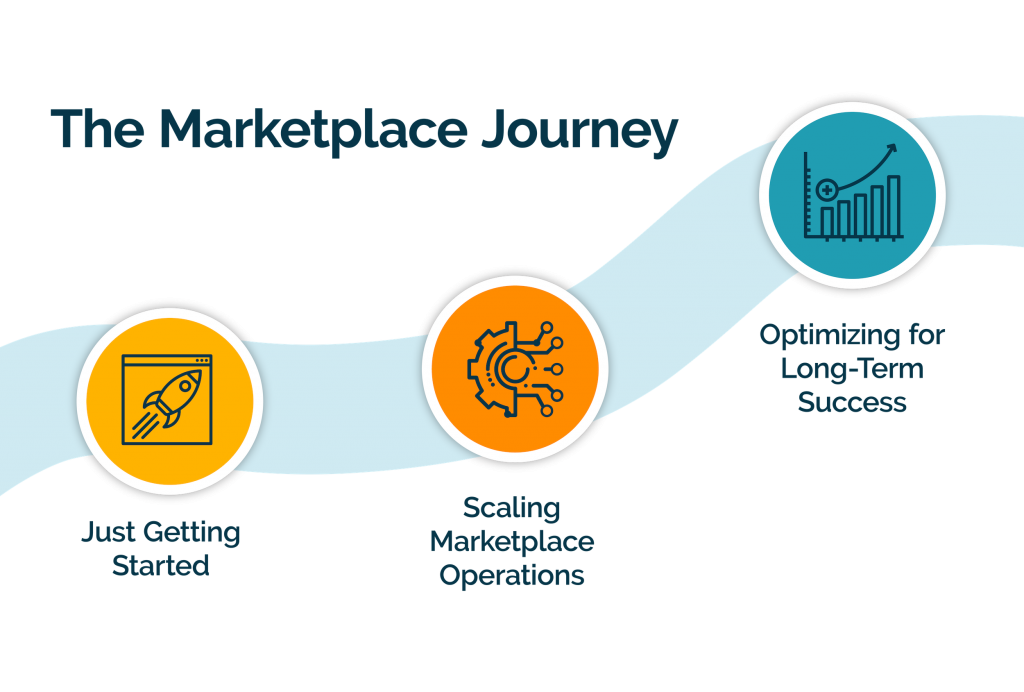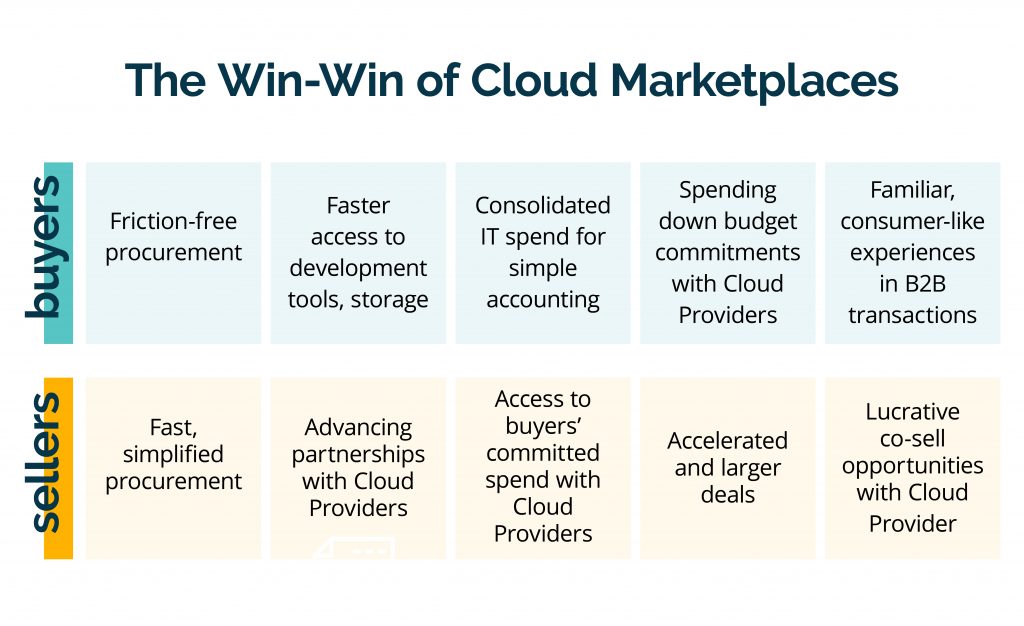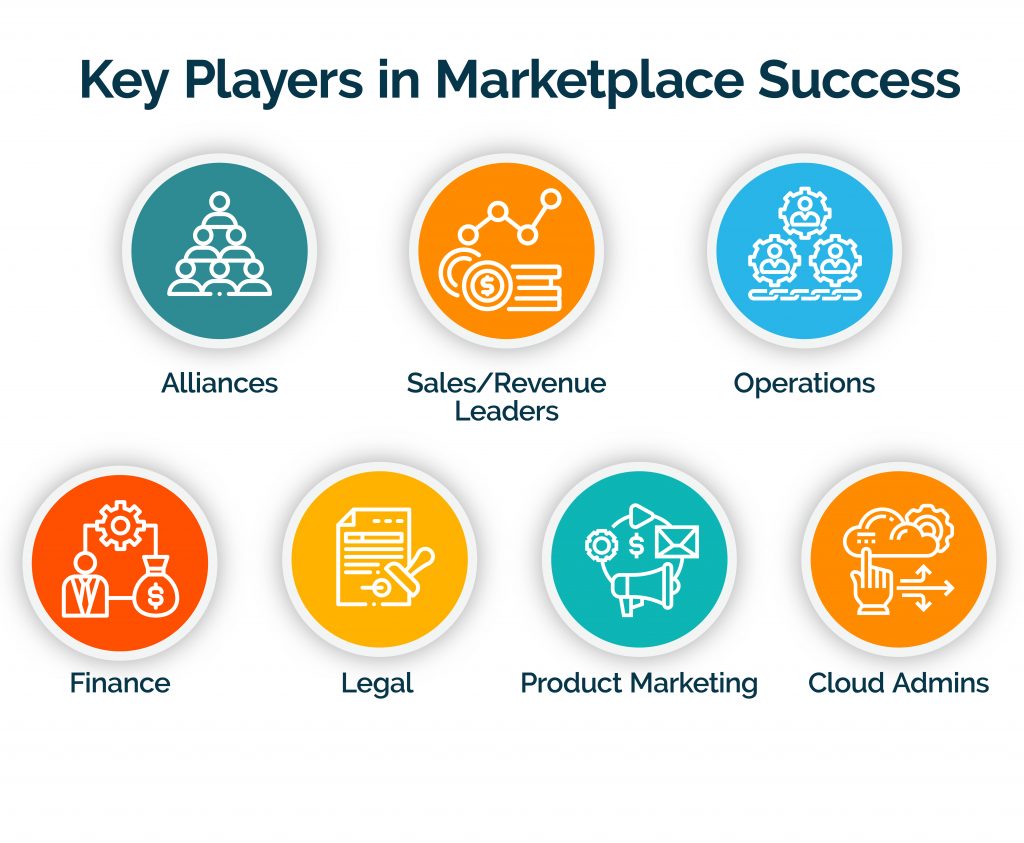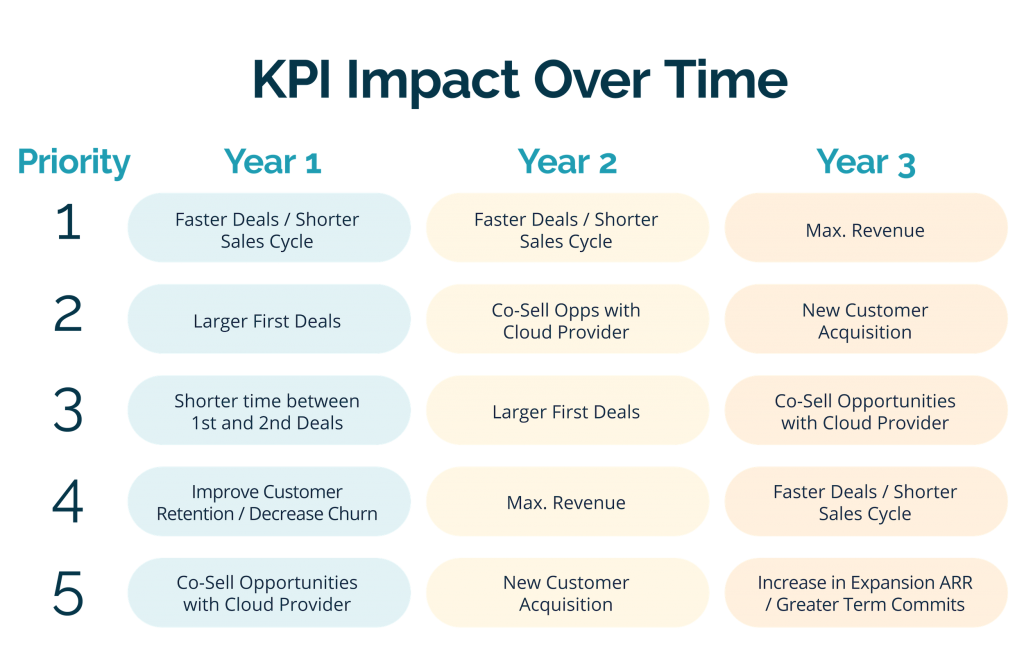Selling on Cloud Marketplaces at Each Stage of Maturity
Jump to a Category
About This Playbook: Guidance for Growth
In this playbook, you’ll find key strategies for each step of your Cloud Marketplace journey, from getting started to scaling and operationalizing—complete with expert advice from leaders in the field at companies like CloudZero, HashiCorp, CrowdStrike, and more.
The mass migration continues: More software sellers are leveraging Cloud Marketplaces as a critical leg of their go-to-market strategy, and they are seeing results such as:
- Larger deals
- Accelerated deal velocity
- Decreased time spent on negotiation and vendor management
- Access to millions of buyers where they already have budget
- Profitable co-sell opportunities
Early Marketplace adopters are realizing substantial returns, according to the State of the Cloud 2021 report from Bessemer Venture Partners. For example, in 2020:
- Identity and authentication platform Auth0 experienced 10x year-over-year revenue growth
- Cybersecurity leader CrowdStrike saw sales cycle times cut by nearly half
These are two examples of many.
As with any emerging sales channel, there’s a learning curve with Cloud Marketplace transactions. The experiences of a company preparing its first listing differ from those of a company with greater Marketplace maturity.
What are the main differences? How do companies generate momentum and scale to close more and bigger deals?
To answer those questions, Tackle held several candid discussions with experts from companies in various stages of their Marketplace journey. We asked them to share advice and best practices for those:
- Just getting started (not yet selling on Cloud Marketplaces)
- Scaling Marketplace operations and presence
- Optimizing Marketplaces for long-term success
Their insights appear in this Playbook. Use them to guide each step of your company’s Cloud Marketplace journey.

The Business Case for Cloud Marketplaces
For the world’s leading cloud companies, Cloud Marketplaces are now go-to-market necessities, not options. The numbers—both realized and forecasted—tell why:
- More than 45% of Cloud 100 companies are active Marketplace sellers.
- The committed enterprise spend flowing through the three major Cloud Providers exceeds $250 billion per year—and that number is climbing fast.
- For 2021 alone, ISVs will generate over $3 billion in revenue through the Cloud Marketplaces, based on Bessemer predictions. Bessemer expects that to grow by a multiple of 10 in the coming years.
- By 2025, nearly 80% of sales interactions will take place through digital channels, according to a recent study published by Gartner.
- Forrester had projected that 17% of the $13 trillion global B2B spend would flow through ecommerce and Marketplaces by 2023—but that number could now be reached in 2021.
- A 2020 Tackle survey found that 70% of software sellers said they have increased focus and investment in Marketplaces as a go-to-market channel due to COVID-19.
The explosive growth of Cloud Marketplaces results largely from the mutual advantages they offer to buyers and sellers.

Stage 1: Preparing to Launch
Motivations vary for entering Cloud Marketplaces. Many vendors add it to help strengthen their Cloud Provider partnerships. The primary allure is getting in front of buyers where they already have committed budgets.
“We closed deals at the end of 2020 because of the buyer’s committed spend. We might have had to wait for the next budget cycle. When your customers have agreements in place with Cloud Providers, budget approval is faster,” said Eric Elias, Operations at Astronomer.
Regardless of motivation, all Marketplace journeys begin with setting up the initial listing.
Marketplace Mechanics
Essentially, you have two options:
“I wanted a frictionless way to enter the Marketplace without the complexities of learning everything, from deciding what kind of listing we want to the business terms, the contractual terms, and so forth.”
—Bill Mann, CEO, Styra
- Do it yourself. In this scenario, in-house engineers must devote substantial time and effort to learning about the intricacies of Marketplace listings and configuring APIs for multiple Cloud Providers and transaction scenarios. The initial listing process can take 4-6 months or more to complete, assuming your engineers divide their time among Marketplace and mission-critical work on your core products.
- Outsource to specialists. For sellers without extra engineering capacity or who need to decrease time-to-Marketplace, teaming with a specialist like Tackle and our zero-engineering platform can accelerate the entire listing process. With Tackle, sellers commonly start selling and closing deals in just a few months or even weeks, meanwhile engineers remain focused on development and differentiation for your products(s).
Read this practical breakdown on the build vs. buy decision for Marketplace.
Considerations for Launching on Cloud Marketplace
Building your team
Like any significant new sales motion, Marketplace requires buy-in from the top—you need an executive sponsor.
“We believe online marketplaces will be one of the biggest opportunities to sell software and recommend partnering with the CFO and procurement leadership to shift from a focus of executing transactions to delivering ROI through self-service, velocity, and volume,” said Shelly Landsmann, VP of International Sales & Global Alliances at Sisense.
Learn how to make the business case to your C-suite.
Then, as you build your strategy, consider assembling a Marketplace Expedition Team that aligns leadership from different departments (and significantly increases your chances for lasting success.) This team includes leaders from:
- Sales
- Sales/Revenue operations
- Alliances
While responsibility for the Marketplace will likely live with your Sales department, it’s truly a cross-functional endeavor touching all facets of your organization. Key players on your internal team in addition to sales will likely include:
- Alliance managers
- Cloud administrators
- Product marketing/management leaders
- Finance and operations personnel
- Legal advisors
 You’ll also need to train your sales and account representatives on how the Marketplace works, the role they will play, and why this channel benefits everyone. This won’t be a one-and-done session, but an ongoing part of your efforts. We’ll dig into sales enablement and training specifically in a section a little further down.
You’ll also need to train your sales and account representatives on how the Marketplace works, the role they will play, and why this channel benefits everyone. This won’t be a one-and-done session, but an ongoing part of your efforts. We’ll dig into sales enablement and training specifically in a section a little further down.
To fee or not to fee
New entrants to the Marketplace (and even those with years of experience) frequently struggle with how to handle Marketplace transaction fees. Should they pass them through to buyers or absorb them in the interest of getting more wins?
Experts suggest the smart move is accounting for these fees as a cost of sale, which allows you to account for top-line revenue and doesn’t impact your buyer (or sellers).
“We try to keep pricing simple for the customers and therefore are eating the Marketplace fees,” said Eric Elias, Astronomer. “The benefits of the Marketplace, faster close times and additional customers offset the transaction costs. Our sales folks will have more time to close more deals in the long term.”
Announcing your presence
“Build it and they will come” does not apply to Cloud Marketplaces. Like other sales channels, customers need to know your listings are up and you’re ready to do business. You may need to educate customers and prospects about transacting on the Marketplace. Emphasize the buyer benefits, including faster deals and spending down their budget commitments with Cloud Providers.
“Your account executives will let the customer know early on when it’s a Marketplace transaction and what details that includes,” said Erik Peterson, Founder and CTO/CISO at CloudZero. “That might require conversations with the customer’s CIO instead of procurement, since the CIO may need to approve the transaction.”
Learn how you can drive organic traffic to your Marketplace listing.
Private Offers, public deals, or both
Cloud Marketplaces offer tremendous transaction flexibility. As in the B2C world, sellers can offer public deals where buyers click to purchase tools, services, and storage, or opt for metered “pay-as-you go” arrangements.
“It feels nice when you tell a customer, ‘We’re going to send you a Private Offer.’ It provides a personal experience and adds to the speediness of the deal.”
—Eric Elias, Astronomer
Private Offers, meanwhile, use the Marketplace as a gateway for building a relationship around a transaction. Private offers give sellers more control over customizing special terms and conditions and other negotiations, and they are the most common method for transactions through the Marketplaces.
A Private Offer-centric strategy also reduces any product integration requirements and treats Marketplace as a fulfillment vehicle, allowing you to remain in control of the deployment of your software.
Another bonus: Cloud Providers look favorably on Private Offers. “Providers have a lot of interest in seeing private offers,” said Erik Peterson, CloudZero. “It helps them and creates opportunities to partner with them on deals.”
Setting goals for Cloud Marketplace
Launching a new go-to-market channel is exciting, and it’s easy to get swept up in the possibilities. There’s a good chance you will quickly see action, especially if you partner with Tackle to accelerate the process. But early entrants advise, when establishing KPIs for your first year on the Cloud Marketplace, it’s important to be realistic.
“You may be hoping that, suddenly, a million deals will start pouring in because you’re on the Marketplace,” said Erik Peterson, CloudZero. “You still have to do the usual selling and marketing.”
Part of remaining realistic can involve setting goals around time to close and the overall reduced friction in each transaction rather than the number of deals. “The early Marketplace deals had a higher average deal value and a faster sales cycle,” said Eric Elias.
Also remember that you’ve already achieved a major goal. “Getting established on the Marketplace was the big achievement for year one,” said Bill Mann, Styra. “The only metric at the moment for me is just to get some deal flow going, and then we’ll take it from there.”

Take the MVP Approach
Speaking of getting going, don’t let perfection become the enemy of participation. You may not start with the most robust Marketplace presence, with a fully embedded product and all the bells and whistles activated. That is not a problem. Many sellers take the MVP approach, or minimum viable product.
Instead of delaying and waiting for all the stars to align, just establish your listing as best you can with assistance from Tackle and the Cloud Provider. Make your Marketplace motion as similar as possible to your direct selling motion. Once you are in and have built up some familiarity, then you can take steps to expand and improve.
Stage 2: Scaling Up
You’ve achieved a few Cloud Marketplace wins. You’ve generated momentum with your internal teams, and you’re gaining traction with new prospects. You’re now ready for more and larger deals.
Where do you go from here?
In the literal sense, “where” can be a matter of adding another Marketplace to your channel mix. If you sell on AWS, for example, you may want to consider moving to Azure or GCP. Eventually, you could end up selling on all three hyperscalers. Each one has its own terminology, requirements, and way of working, so it’s not a matter of simple replication. Prioritization is key.
“Even if your company has meaningful business relationships with all three of the major Cloud Marketplaces, strategically start with one that best aligns with your sales goals, learn and refine self-service processes, and then expand into the next one,” said Shelly Landsmann, Sisense.
Figuratively speaking, where you go next covers lots of opportunities.
Considerations for Scaling Cloud Marketplace Sales
Co-selling with Cloud Providers
Symbiotic relationships are hallmarks of Cloud Marketplaces. In the previous section, we spelled out a few major benefits for both buyers and sellers. We can’t forget about the Cloud Providers themselves.
As the popularity of Marketplace has increased, it has become a foregone conclusion that if you’re a co-sell partner, you should be on Marketplace as well.”
—Will Hornkohl, Nasuni
Cloud Providers have a significant stake here—and a shared interest in helping you close more and bigger deals. Each time you complete a transaction, you bring new work into the cloud, increasing consumption for Cloud Providers.
Their co-sell programs are typically available to reward and incentivize active Marketplace sellers with access to exclusive resources, tools, leads, and opportunities. Learning how to establish and navigate co-sell opportunities with Cloud Providers can stimulate growth and bring you to another level, but it can also be a slow and tedious process for most sellers.
You can also reap the rewards of Marketplace incentives that Cloud Providers offer their customers, including Enterprise Discount Programs (EDPs), Enterprise License Agreements (ELAs), and Partner/Reseller-centric programs designed for larger deals.
“We closed one of the largest transactions in our company’s history through Marketplace, and it required very close co-selling with our partners,” said Will Hornkohl, VP of Global Alliances at Nasuni. “As the deal began to expand and become a multi-year picture, the customer realized this would be a strong opportunity to help reach their multi-year spend commit they had in place with the Cloud Provider as well.”
Pricing and packaging for Cloud Marketplaces
As you prepare to escalate your Marketplace activity, first evaluate and refine your goals, especially in terms of pricing and packaging. You can now apply your experiences when viewing pricing and packaging, applying what you’ve learned from your early days in the Marketplace trenches.
For instance, if you offer a public sales listing, have you built in triggers for following up to ensure customers ordered the correct SKU—and to engage in conversations that potentially expand the account?
If you haven’t explored Private Offers, now is the time. They allow you to map your existing sales process to the Cloud Marketplace, and they are the most successful avenues for software sellers. Curating custom deals allows you to engage buyers and tap into their committed cloud spend while leveraging the same sales motion you use when selling direct.
For public and private deals, let history guide you. Regularly review past sales and look for trends to find opportunities for bundling features and add-ons based on demand.
As for packaging, best practices say resist the urge to reinvent. Mirror your direct sales process as much as possible when packaging your listing in relation to initial deals, expansions, and renewals. If the offer you list is limited or doesn’t match the way your sellers sell, it will be hard to get traction.
Get six tips to perfect your Marketplace pricing and packaging.
Ongoing education
Scaling effectively means maintaining an engaged sales team. By now they’ve seen firsthand the value and potential of Marketplace to help them close more deals faster. Continuing to educate sales reps about how Marketplace works and how to sell the channel to your customers is imperative for any scaling success and continued growth.
Selling on Cloud Marketplaces can feel a little like visiting a foreign country. There’s a new language and different customs. The more versed you are in a foreign culture, the more likely you are to have positive experiences. This includes knowing which questions to ask customers and determining which ones are good candidates for Marketplace deals.
“I now have an expert in the field that knows the language of Azure, AWS, and GCP. Their job is bringing the sellers together, having constructive conversations, and then executing,” said Will Hornkohl, Nasuni. “That’s been the core of our success around co-selling, so we’ve extended that into the Marketplace.”
Your sales reps already know how to sell the benefits of your products and services. Make sure they also know how to sell the benefits of a Marketplace transaction. For instance, they can build customer Marketplace advantages like flexibility of procurement and access to budget into their sales pitches, or make sure Alliance sellers understand what they stand to gain from these transactions, including earning more quota credit for customers buying through Marketplaces.
Cloud Providers can provide scientifically formulated sales support to your teams via propensity to buy analyses. Providers use algorithms to determine a customer’s likelihood to buy on Marketplaces based on factors like spending commitments, agreements, and Marketplace usage.
“In one quarter, we had 32 different sales representatives transact on Marketplaces,” said Aldo Dossola, AVP of Worldwide Clouds Sales & GTM at HashiCorp. “It was great to see more people realizing how easy it is and how they can compress deals that [previously] would have taken weeks into just a couple of days.”
Here’s how you can arm your sales team to talk about Marketplace with their prospects.
Marketplace compensation strategies
Nothing inspires a sales team to engage with a channel like attractive compensation. As you look to scale sales, consider how you reward and incentivize on the channel. Some sellers use spiffing, or immediate bonuses on Marketplace sales, especially in the early days.
A word of caution: Your plan should ensure compensation neutrality—meaning Marketplace fees won’t impact sales compensation or commissions. And remember, you can always change compensation plans over time after you start seeing growth. Your path to success will be much faster if you don’t disincentivize your sales team.
Learn more traits and tactics of successful Marketplace sellers.
Stage 3: Operationalizing Cloud Marketplaces
You’ll have learned many lessons once you reach this stage, typically coming in around year three of selling on the Marketplace(s). The channel at this point has evolved from an ambitious idea to an exciting anomaly to an integral part of your sales motion.
Fully operationalizing and optimizing the Cloud Marketplace requires continued attention to the essentials you focused on and perfected early on. You can tap into your experiences and use maturity as a lever for bigger and better results.
Considerations for Operationalizing Cloud Marketplace Sales
Support from the top
Remember when you first pitched Marketplace as a go-to-market option? How you made a case for the ROI and convinced the CFO to take the leap? To maintain your Marketplace momentum, you’ll need to expand that work and win over the broader C-suite team and board of directors.
Getting their attention should be easier now that you can report on actual Marketplace results.
“During the pandemic, we rescued a number of large, seven-figure deals and were able to close them as projected because of the customers’ committed spend. When you have those success stories, it gets the attention of the C-suite,” said Abhi Madhugiri, Director, Global Strategic Alliances at AppDynamics.
Expanding co-sell programs
Co-sell programs make the Marketplaces work harder for you—without making your own work harder. Becoming a go-to partner for your Cloud Provider means you’ll gain access to new opportunities in the pipeline, learn about customer spending commitments, and deliver value to customers that pay long-term dividends.
You may be ready to branch out to Consulting Partner Private Offers (CPPO), which allow third parties to sell on Marketplaces on your behalf.
“We see CPPO as an opportunity to help channel partners innovate, modernize and align with AWS.” said Jessica Alexander, VP of Cloud Sales & Partnerships, CrowdStrike. “Over 80% of our revenue is indirect, so we wanted a way to include them in our process and reap the benefits of the digital transformation journey our customers are on with AWS.”
Aligning sales strategies
Marketplace is now the third leg in the go-to-market stool, taking its place alongside direct and channel sales. How do you make them all work better together?
Vendors have found success with an overlay model, in which a designated cloud sales team overlays direct sales teams and field sellers. They share a common goal of surfacing opportunities and exploring viability for Marketplace deals.
“Our cloud sales executives are quarterbacking for the field sellers. They’re working with them hand-in-hand once they’ve validated an opportunity, and the field sellers don’t have any additional burden,” said Abhi Madhugiri.
Frequent reminders also help keep Marketplace opportunities front-and-center among different sales teams.
“We do lots of reminding and repeating at all-hands meetings on the power of the Marketplace and the power of the cloud partner. There must be a very deliberate, intentional effort to grow the Marketplace business,” said Abhi Madhugiri.
The Marketplace Center of Excellence

One of the best ways to operationalize the Cloud Marketplace channel: building a Center of Excellence (CoE). Your CoE can house a team of dedicated enablement experts focused on improving CPPOs and reducing friction areas in Marketplace deals. They can apply their expertise and experience with Marketplaces to manage high-velocity transactions, create Private Offers, interface with the Marketplace customer operations desk, and make the entire process seamless.
A Platform and Partner for Every Stage
“The partnership with Tackle allowed me to handle what I needed to while they handled all the infrastructure and management. They see everything and are my best trusted advisor.”
—Shelly Landsmann, Sisense
From the first listing to the 100th deal and beyond, software vendors rely on Tackle’s Cloud Marketplace Platform and support team to see results at every stage.
Tackle removes the barriers that prevent software vendors from reaping the advantages of selling in the Cloud Marketplaces. Often in a matter of weeks, Tackle can help sellers list any kind of product and engage new customers across all three major Marketplaces—no in-house engineering required. Tackle’s custom reporting offers enhanced customer visibility along with revenue forecasting to maximize listings.
Our team works with yours to create Private Offers, scale up transaction volume, and integrate Marketplace into your long-term sales strategy.
Schedule a demo to see how we can help you.


